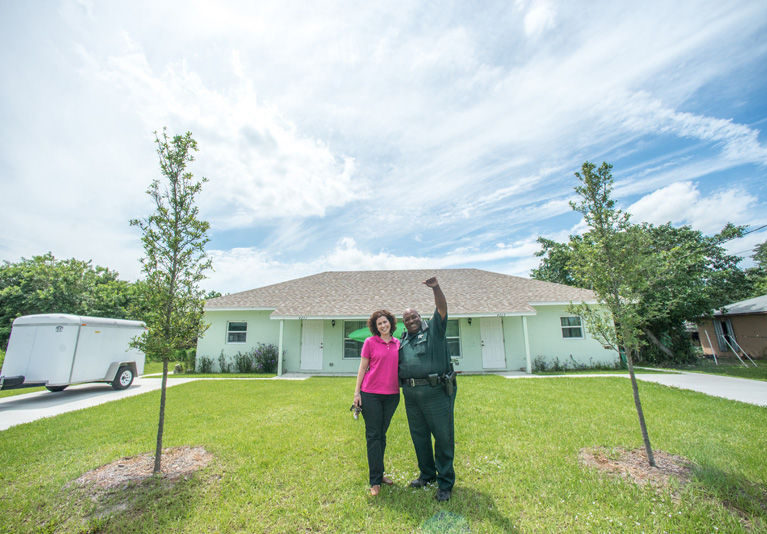
In the aftermath of the three longest wars in U.S. history (Vietnam, Iraq and Afghanistan), veterans’ health services in this country have been stretched to and sometimes well beyond their limits. Promises made to veterans have, in many cases, been promises broken.
Vero area veterans, however, appear to be getting the medical and mental help they’re entitled to far faster than veterans in many other parts of the country, according to Amarah Dawes, chief of medical administrative services for the West Palm Beach veterans’ medical center and Mary Ann Goodman, the center’s public affairs officer.
Veterans needing medical care in Vero are greatly aided by housing facilities created by local nonprofits supported by generous donations.
Both VA officials claim that figures from January of this year show that 97 percent of veterans at the West Palm facility get appointments within 30 days and at the Vero Beach outpatient clinic that figure rises to 99 percent.
Documents obtained from the Veterans Support System Center showing activity through February of this year actually show slightly better numbers. They show veterans at the West Palm Beach facility getting appointments within 30 days at 98.23 percent and at 99.34 percent in Vero Beach.
That’s not the case elsewhere. Horror stories from Veterans Administration healthcare facilities in Arizona, Los Angeles, Charlottesville and even Jacksonville, FL, have grabbed headlines and filled the airwaves coast to coast with large numbers of veterans waiting six months or more just to get an appointment.
The Jacksonville clinic, according to the Florida Times Union, “falls far behind” clinics half its size with many veterans waiting four months and more for appointments. The paper calls that clinic, “the worst among major facilities in the country.”
This region’s VA healthcare system, according to Dawes, includes the main West Palm facility as well as six community-based outpatient clinics or “C-BOPs” including Vero, Fort Pierce, Stuart, Okeechobee, Delray Beach and Boca Raton. Goodman says 48 percent of veteran patients are seen at the C-BOPs with 52 percent going to the West Palm facility.
“We’ve also been offering extended hours at C-BOPs,” says Dawes, citing a new 7:30 a.m. start time in Vero Beach for lab work. Goodman touts the expanding use of “tele-medicine” or medical video conferencing as another step to keep the backlogs plaguing many veterans’ facilities nationwide from occurring here.
More than two dozen new support staffers have been authorized in the region this year to help keep veteran care accessible and hopefully to further reduce wait times.
Nationwide the VA’s healthcare workload skyrocketed from some 63 million outpatients in 2007 to over 100 million this year. Moreover, as Vietnam veterans age and require more care, veterans from Iraq and Afghanistan are presenting new and more complex health challenges including traumatic brain injuries, multiple limb amputations, diabetes and post-traumatic stress disorder.
According to Goodman, Vietnam veterans make up the single largest group seen by VA physicians on the Treasure Coast at 44 percent of the total. World War II and Gulf War vets are in a near dead-heat at 18 and 17 percent, respectively, while Korean War vets and veterans of the 13-year-long war in Afghanistan make up the bulk of the rest. Some 91 percent of patients seen are men and 9 percent are women.
Goodman says one problem is that, “sometimes it’s challenging to get in touch with patients.” One factor that’s new to this generation is the shockingly high number of returning combat veterans who have become homeless since their discharge.
Medical and psychological problems are among the most likely causes for veteran homelessness and a call or text message to someone with no place to charge his or her phone is just an exercise in futility. An email with an appointment time to someone with no computer (or a place to put one) is equally useless.
In Vero Beach a host of island residents are leading a charge to help returning war veterans find homes.
Picture a cavalry charge in your mind’s eye. Now picture barrier island residents Ron Pettirossi, John Kerney, Richard Dunlap, Dennis Witherow, Michael Lally, Tony Young and a host of others taking the place of John Wayne, Randolph Scott and Errol Flynn.
That’s just what Julianne Price sees when she looks at the duplex building at 4211 and 4213 24th Court and the construction site at 1855 38th Place. Price, the president of the non-profit organization “Every Dream Has a Price” is also the Environmental Health Coordinator at the Florida Department of Health in Indian River County. Those two addresses are new duplex housing units for disabled veterans here in Vero.
Price says those projects never could have been undertaken if it hadn’t been for what she calls her “cavalry coming to lead the charge.”
When Price and fellow “Every Dream Has a Price” member Teddy Floyd of the Indian River Sheriff’s Department first envisioned these projects, they saw multiple hurdles in their path. But with the help of another local nonprofit, “Homes for Returning Disabled Veterans,” their impossible dream started to seem more and more plausible.
Local architect Rob Adkins and structural engineer Michael Lue quickly signed on, as did civil engineer Steve Moler. “We feel it’s important to give back to the community,” explains Lue.
(In an “only-in-Vero” moment, when volunteers were called to help hand-clear the lot on 38th Place, Price recalls seeing a Rolls Royce parked among the pickup trucks.)
In any event, working with the John’s Island Foundation and the Grand Harbor Outreach Foundation, Price says they hope to begin moving 10 disabled veterans into the two 38th Place three-bedroom, two-bath homes by Christmas of this year.
Two new duplex housing units and shorter wait times for medical appointments on the Treasure Coast won’t solve all veterans’ problems but they certainly are steps in the right direction.



